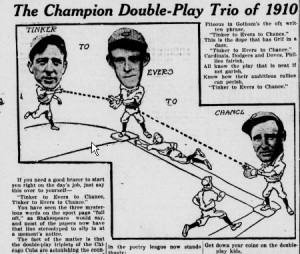Here are two quick questions to consider on Major League Baseball’s Opening Day:
1) What is your favorite baseball poem?
2) What is your favorite baseball poem—other than “Casey at the Bat”?
Most people can easily answer the first question, but are stymied by the second question because, in all likelihood, they’re unable to name a baseball poem—any baseball poem—besides “Casey at the Bat.”
One baseball poem that deserves to be known as much as Ernest Thayer’s “Casey at the Bat,” if only for the influence it may have had on baseball history, is “Baseball’s Sad Lexicon.” The poem, written by Franklin Pierce Adams for his “Always In Good Humor” column in New York’s The Evening Mail, was published in the July 12, 1910 issue of the paper under the title “That Double Play Again.” Pierce’s poem immortalized the fearsome Chicago Cubs double play combination of shortstop Joe Tinker, second baseman Johnny Evers, and first baseman Frank Chance, who had flashed enough leather against Adams’s New York Giants to make him lament in verse:
These are the saddest of possible words:
“Tinker to Evers to Chance.”
Trio of bear cubs, and fleeter than birds,
Tinker and Evers and Chance.
Ruthlessly pricking our gonfalon bubble,*
Making a Giant hit into a double–
Words that are heavy with nothing but trouble:
“Tinker to Evers to Chance.”
The poem was an immediate hit with Adams’s fellow sportswriters and readers, some of whom wrote their own verses paying homage to the trio (and parodying Adams’s poem in the process). The article “The Champion Double-Play Trio of 1910” from the September 5, 1910, issue of The Spokane Press, available through the Library’s Chronicling America Web site**, includes several additional stanzas about the “three knights of the double-play.”
Tinker, Evers, and Chance helped lead the Cubs to four National League pennants (1906-8, 1910) and two World Series wins (1907-8), and were simultaneously inducted into baseball’s Hall of Fame in 1946. Many baseball historians and fans believe that Adams’s poem, as much the players’ on-field accomplishments, helped them secure a spot among baseball’s all-time greats, and as such “Baseball’s Sad Lexicon” is a poem every baseball fan should know.
*The word gonfalon refers to a flag or pennant.
**See the online guide Baseball Resources at the Library of Congress to learn about additional baseball resources available at the Library.



April 2, 2012 at 4:34 pm
Not to be a spoilsport, but there are dozens of wonderful baseball poems to choose from. A few examples I’d include are “Baseball” by John Updike, “Baseball and Classicism” by Tom Clark, and “Forgiving Buckner” by John Hodgen. My favorite, though, is “Baseball Canto” by Lawrence Ferlinghetti, in which members of the San Francisco Giants, circa 1965, shatter the Anglo-Saxon grip on the sport.
April 2, 2012 at 11:36 pm
Now I better understand to what my dad – who passed on his love of the Cubs to me – was referring when he mused “Tinker to Evans to Chance”. Well done, Peter! Thanks.
April 3, 2012 at 8:21 am
Thanks for the great recommendations, Aaron. My own favorite baseball poem is B.H. Fairchild’s “Body and Soul,” which appears in his book “The Art of the Lathe” (Alice James Books, 1998).
April 3, 2012 at 1:55 pm
Great post with highlights of rich Library of Congress collection connections!
April 7, 2012 at 10:07 am
This is priceless, Peter. Thank you very much. I’ve read elsewhere that F.P.A.’s poem, which he supposedly wrote on the fly when told by his newspaper’s composing room that his column that day was 8 lines short, went unremarked for many years. This certainly puts the lie to that shiboleth, which was also used to denigrate the Hall of Fame induction of Tinker, Evers and Chance. Are there other examples of newspapers picking up on the verse in 1910? I’m doing research on the Chicago Cubs team of that era and would love to know more. Thanks again.
April 10, 2012 at 10:44 am
Excellent post — and comments!
Forgiving Buckner is on the Library’s site at http://www.loc.gov/poetry/180/154.html